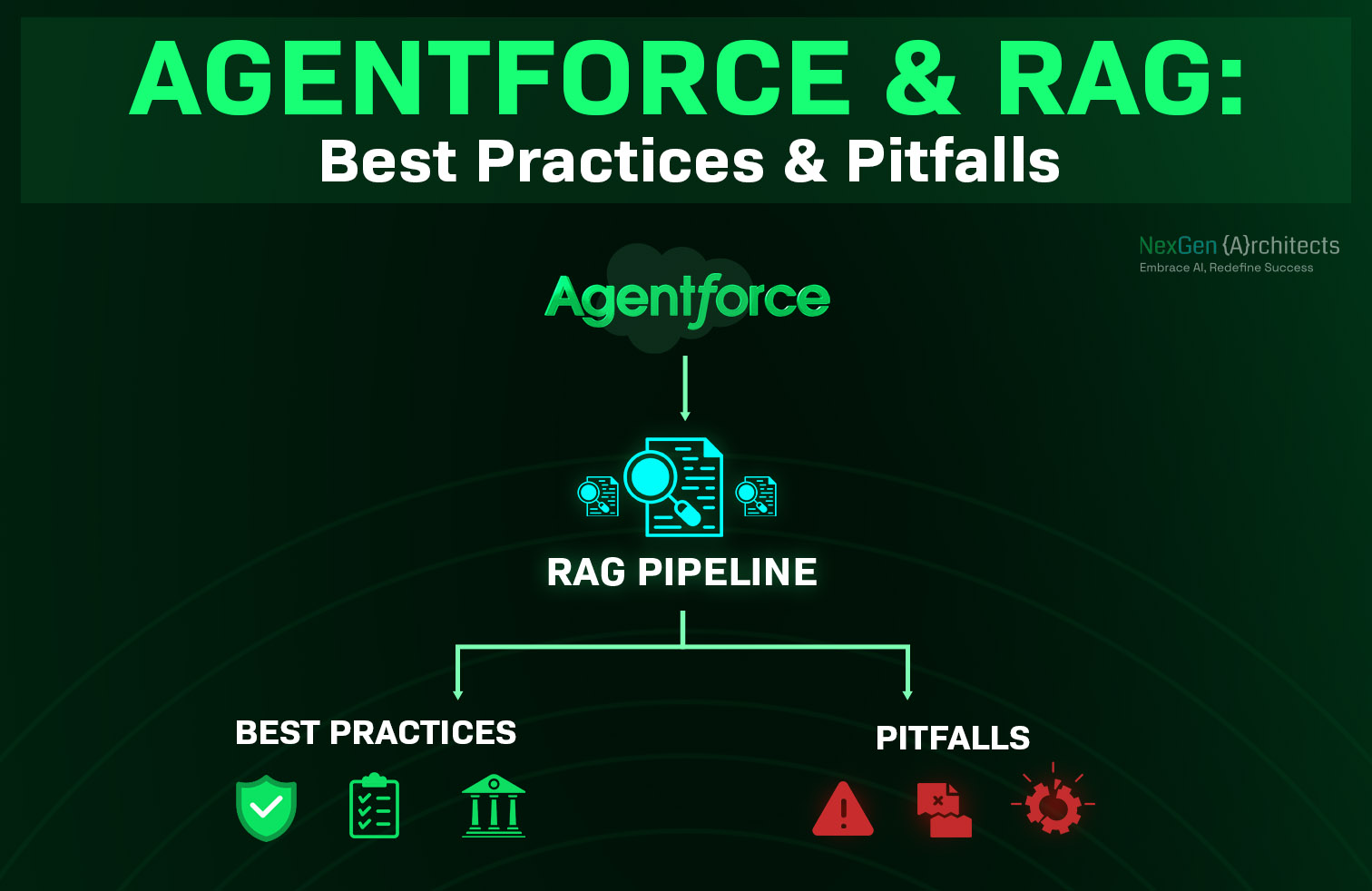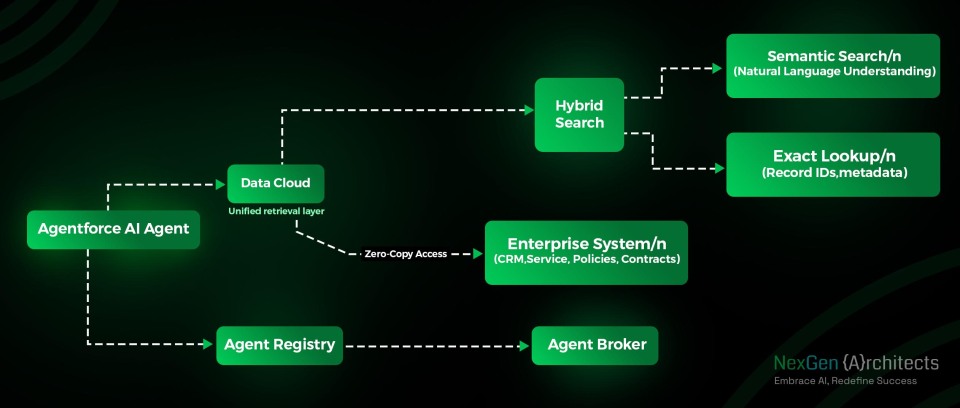Agentforce and RAG: Best Practices & Pitfalls in Enterprise AI
Learn how Salesforce Agentforce leverages RAG to power trusted AI agents. Explore best practices, pitfalls, and enterprise-ready governance strategies.

AI agents are quickly moving from experiments to enterprise reality. Salesforce’s Agentforce is at the front of this wave, bringing AI agents directly into CRM workflows, customer service, and cross-department processes.
But there’s a catch: LLMs are only as good as the data they’re grounded in. Without grounding, agents hallucinate, contradict existing records, or misinterpret context. That’s where RAG comes in.
RAG makes Agentforce agents context-aware, by retrieving information from trusted sources before generating a response. Done right, it’s the difference between an agent that guesses and an agent that works responsibly with enterprise data.
This blog explores how Agentforce leverages RAG, best practices for implementation, common pitfalls to avoid, and the future of trusted agentic AI in enterprises.
Advantage of RAG in Agentforce
Agentforce is like a colleague that’s sharp, quick, and able to understand natural language. But what makes them truly valuable is access to the same data and policies your teams already rely on.
That’s what RAG provides to Agentforce:
- Factual grounding in live business data.
- Consistency across departments and workflows.
- Scalability without sacrificing governance or compliance.
By weaving RAG into the agent’s workflow, Salesforce has ensured that Agentforce is not only intelligent but also trustworthy and enterprise-ready.
How Agentforce Uses RAG
Salesforce has embedded RAG directly into the design of Agentforce. This ensures every agent action is grounded in enterprise data and governed access. Here’s how Agentforce works using RAG:
1. Data Cloud at the Core
Agentforce is connected through Salesforce Data Cloud, which acts as the primary retrieval layer. Instead of each agent pulling data from multiple silos, they query a single governed source that unifies CRM records, service histories, contracts, and policies.
2. Hybrid Search
Agentforce combines two complementary retrieval modes: semantic search and exact lookups.
- Semantic search enables natural language understanding, e.g., “list all open opportunities in healthcare for Q2.”
- Exact lookups fetch specific records tied to metadata or IDs, e.g., customer_id=12345.
Running both modes in parallel allows agents to handle user-friendly queries while maintaining the precision enterprises expect from system lookups.
3. Zero-Copy Design
Agentforce follows a zero-copy principle. Data is never duplicated into external stores. Retrieval happens in place, under governance, and in real time. This reduces risk, eliminates data drift, and ensures compliance standards are met without additional overhead.
4. Agent Registry & Broker
The Agent Registry makes every agent visible and cataloged with its capabilities. The Agent Broker manages how agents interact, so data retrieved by one agent can be securely shared with another. For example, a Sales Agent retrieving opportunity data can automatically pass context to a Pricing Agent, which then hands it to a Service Agent without manual intervention or redundant queries.
This architecture reflects the same discipline found in MuleSoft API-led connectivity, where orchestration and governance ensure enterprise-wide consistency.

Best Practices for Enterprises Adopting Agentforce & RAG
Enterprises looking to operationalize Agentforce with RAG should approach it as a business capability. The following practices help ensure RAG delivers reliable outcomes at scale:
1. Curate High-Value Sources
Start with systems that directly impact customer and business outcomes, such as CRM data, service knowledge bases, and policy repositories. By focusing retrieval on trusted, high-value content first, agents generate responses that provide immediate ROI and establish confidence with users.
2. Enrich Data with Metadata
Metadata improves the accuracy of retrieval and reduces ambiguity. Adding tags such as effective dates, regions, or product IDs gives agents context to select the right information for each request. This step is particularly important in large enterprises where similar documents exist across multiple departments.
3. Apply Governance Rules
Integrate RAG pipelines with Flex Gateway and attribute-based access controls (ABAC). These ensure agents only retrieve data aligned with user roles and that sensitive information remains protected. Governance should be enforced at the retrieval layer, so compliance is embedded by design.
4. Refresh Indexes Regularly
Data evolves constantly. Embeddings and indexes must be updated to reflect new schemas, record changes, and policy updates. Regular refresh cycles prevent outdated content from influencing agent responses and ensure RAG always reflects the most current enterprise truth.
5. Run Scenario Testing
Before scaling, test RAG workflows against real business scenarios. For example, validate how a sales agent retrieves current pricing, or how a service agent references the latest support policy. Scenario-based testing highlights gaps early and proves that the RAG pipeline supports production-grade reliability
Common Challenges to Be Aware
Agentforce embeds RAG into its architecture, but enterprises must still plan for operational realities as they scale. These are not limitations of the platform, they are design choices that determine how smoothly RAG-powered agents perform:
1. Performance Tuning
Agentforce agents often serve mission-critical workflows in sales, service, and operations. Retrieval must be fast enough to keep up with live interactions. Enterprises should tune query pipelines in Data Cloud and Hybrid Search to minimize latency, using caching and optimized embeddings for frequently accessed data.
2. Indexing Strategies for Different Data Types
Not all enterprise data behaves the same way. Contracts and policies may need to be chunked into smaller sections for precise retrieval, while CRM records are often best retrieved in full. Agentforce supports both, but enterprises should design indexing strategies tailored to each data domain.
3. Compliance Alignment
Agentforce integrates with Flex Gateway and attribute-based access controls, but enterprises should still align retrieval flows with internal compliance frameworks (GDPR, HIPAA, SOC2). This ensures every RAG-enabled workflow meets industry and regional regulatory standards.
4. Monitoring and Observability
Observability is critical when agents act autonomously. Dashboards in Agentforce’s Visualizer and supporting observability tools should track which data sources are retrieved, how frequently, and with what accuracy. This provides leaders with confidence that agents are operating within defined policies.
Future of Agentforce and RAG
Salesforce continues to evolve Agentforce and RAG together, anticipating the needs of large-scale enterprises. Key directions include:
1. Semantic and Symbolic Retrieval
Agentforce already supports hybrid search. The next step is combining semantic retrieval with symbolic reasoning (rules, knowledge graphs) to sharpen accuracy. This allows agents to not only find relevant data but also reason over structured policies and dependencies.
2. Audit-Ready Retrieval Traces
Enterprises demand transparency. Future versions of Agentforce are expected to provide retrieval traces showing which sources informed a given agent response. This creates compliance-ready audit logs and builds trust with business stakeholders.
3. Zero-Trust AI Pipelines
Zero-trust principles are extending into AI. In Agentforce, that means every retrieval action will be continuously verified, least-privilege access enforced, and no assumptions made about agent authority. This ensures security is embedded at every step of the RAG pipeline.
RAG is becoming the standard way Agentforce ensures agents deliver outcomes that are accurate, governed, and enterprise-ready.
Conclusion
Agentforce represents the next generation of enterprise AI agents that are scalable, orchestrated, and business-aware. With RAG at the foundation, these agents operate on trusted data instead of relying solely on model memory.
By adopting best practices, addressing operational considerations, and aligning RAG workflows with enterprise governance, organizations can deploy Agentforce agents that are:
- Efficient in execution.
- Credible in responses.
- Compliant with regulatory frameworks.
- Ready to scale across departments and regions.
For enterprises preparing their AI workforce, starting with Agentforce and RAG ensures every agent is production-grade, governed, and trusted from the beginning.
Are you looking to integrate Agentforce into your enterprise workflows for maximum outcomes? Contact Us to have personalized production-grade AI agents into your business.

.svg)

